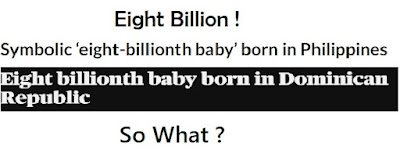Eight Billion! So What ?

I need my morning cup before I can function properly. Since I was alone at home I walked over to Lachhu’s tea-shop for the morning cuppa. The sun was already up and the day had begun as it does in any Indian village. I sat down on the bench, nodded my head towards Lacchu and started scrolling down the messages that had come from the early risers. I had not taken more than a couple of sips, and my sleepy ganglia had just about risen from their torpor when Kannu came up the hill obviously agitated. ‘There you are daksaab. Did you see this news today?’ He said waving his phone at me. ‘Kya hua?’ I asked. ‘Did you know the world population crossed 8 billion yesterday. What will happen now? And the news says that India’s population will become bigger than that of China in one year’s time. We are going to the dogs. No one seems to be doing any thing in Delhi!’ Since it was morning there was some activity at the cluster of four shops that goes as the market of our village. Some people were e...



